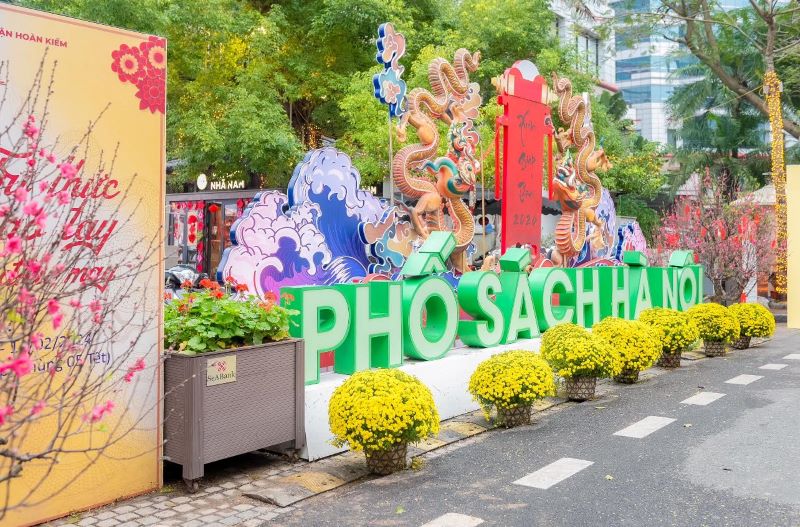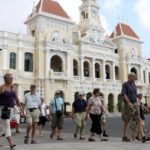Hanoi’s 19 Thang 12 Street, or Hanoi Book Street, is a unique thoroughfare with a name derived from a significant date in Vietnam’s anti-colonial history. Lacking house numbers, this street is a testament to the country’s struggle for independence.
A Street with a Historic Name
 |
| The vibrant Hanoi Book Street, a popular destination for book lovers and culture enthusiasts. |
Located in the heart of Hanoi, 19 Thang 12 Street stretches between the Supreme People’s Court and the Mélia Hanoi Hotel. Spanning over 100 meters, it connects Hai Ba Trung Street to Ly Thuong Kiet Street. The street’s name holds a special significance, marking a tragic yet pivotal moment in Vietnam’s anti-colonial invasion history.
According to historical records, in 1900, this street was known as Rue Palais de Justice, reflecting its proximity to the Palace of Justice. However, in 1933, the name changed to Rue Paul Simoni to honor Paul Simoni, a French colonial official.
A Street Renamed After a Female General
December 1945 witnessed a significant transformation when Hanoi Mayor Tran Duy Hung renamed the street “Le Chan Street.” This new name honored Le Chan, a female general who served under the Trung sisters, Hai Ba Trung, in their rebellion against Chinese Han invaders in 40 AD. The name “Le Chan Street” endured through subsequent street-renaming initiatives in 1949 and 1951, reflecting the importance attached to this historic female figure.
A Witness to Vietnam’s Struggle for Independence
 |
| Hanoi Book Street, a cultural hub in the heart of the city, attracting readers and knowledge seekers alike. |
The street holds a significant place in Vietnam’s struggle for independence. In December 1946, the French army, intent on retaking Hanoi, repeatedly provoked the Viet Minh forces. On December 17, they massacred innocent civilians on Hang Bun Street. In response, President Ho Chi Minh issued a public appeal for national resistance on December 19, a date that would forever be etched in the country’s memory.
That very evening, the 102nd “Capital” Regiment, alongside the Hanoi Citadel Militia, engaged in a courageous battle against the French army. Despite their numerical and weapons disadvantage, the Vietnamese soldiers and citizens fought valiantly, determined to defend their homeland. Many lost their lives at the barricades, their bodies unrecovered.
In the aftermath, French General Jean Valluy ordered his troops to dispose of the bodies by throwing them into bomb shelters on Le Chan Street. These shelters, dug after an Allied bombing in March 1944, served as a temporary resting place for the fallen heroes.
The street also holds a somber memory of the French occupation. During this time, both ends were barricaded, leaving only a small path for civilians to pay their respects to the deceased. It was only after the capital’s liberation in October 1954 that the new government beautified the area, turning it into a proper graveyard.
From “Underground Market” to Cultural Hub
 |
| The former 19 Thang 12 Market, also known as the “underground market,” in the early 2000s. |
In the following decades, the street underwent several transformations. In 1981, the city exhumed the remains and relocated them to the Bat Bat cemetery, now known as Yen Ky cemetery in Phu Son Commune, Ba Vi District. However, the exact number of bone boxes was not recorded, making it challenging to estimate the number of deceased individuals relocated.
After the relocation was completed in 1984, the street was renamed 19 Thang 12 Market to relieve overcrowding in nearby markets. This new market became known as the “underground market” due to its location on the former burial ground.
In 2008, the city closed the market and proposed a commercial center and office space project. However, this plan was met with opposition from historians, architects, and cultural researchers. As a result, the project was suspended, and the city opted for street renovation and the creation of a park instead.
During the renovation process in 2009, workers made a grim discovery. They found bones jumbled together under the road, indicating that the deceased had been hastily buried. After a thorough search, they collected a vast number of bones, filling 497 terracotta coffins. This discovery shed light on the magnitude of the tragedy that had unfolded on this street during the struggle for independence.
Hanoi Book Street: A Cultural Renaissance
 |
| Hanoi Book Street buzzes with activity as visitors flock to browse books, socialize, and immerse themselves in the cultural offerings. |
In 2017, the city of Hanoi made a transformative decision to convert 19 Thang 12 Street into a pedestrian book street. Officially opening on April 30, Hanoi Book Street quickly became a cultural hub, featuring a diverse range of bookstores, flower stalls, and cafes.
With its unique name and profound history, 19 Thang 12 Street, or Hanoi Book Street, stands as a living testament to Vietnam’s anti-colonial struggle and its enduring love for knowledge and culture.
Ancient house in Ma May
NDO – Ma May, a rare quarter that still retains several old houses, has created one of the characteristics of Hanoi. Hanoi’s streets are becoming increasingly crowded and traditional features can sometimes be hidden behind modern life. But if one takes the time to relax and look around, the ancient features begin to reveal themselves.









